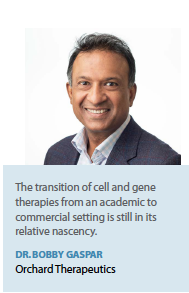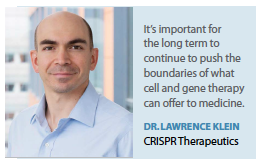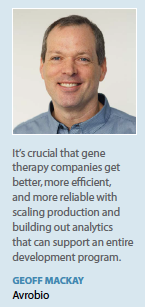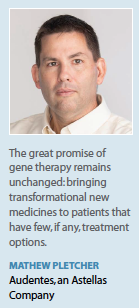Analysts attribute the continued growth of the cell and gene therapy (CGT) market to steady investment and consolidation in cell and gene therapies, with 16 out of the 20 largest biopharma companies adding CGT products to their portfolios.
In the recent past, cell and gene therapies have emerged as promising treatment options for a myriad of complex clinical conditions, including cancers and inherited disorders. According to Roots analysis, currently there are more than 25 such advanced therapy medicinal products available in the market; examples of recently approved therapies include Alofisel (2018), Luxturna (2017), Yescarta (2017), Kymriah (2017), and Invossa (2017). In addition, more than 500 cell and gene therapy candidates are being investigated in different stages of clinical development across various geographies. In fact, in the past five years alone, more than 1,000 clinical trials that are currently active were initiated to evaluate the potential of these therapies across multiple therapeutic indications.
 While overall the cell and gene therapy (CGT) market continues its healthy expansion, this past year wasn’t completely smooth. As was the case in many life-sciences sectors, growth in the CGT market was markedly slowed by COVID-19 due to disruption of the supply chain and restrictive containment measures involving social distancing and remote working.
While overall the cell and gene therapy (CGT) market continues its healthy expansion, this past year wasn’t completely smooth. As was the case in many life-sciences sectors, growth in the CGT market was markedly slowed by COVID-19 due to disruption of the supply chain and restrictive containment measures involving social distancing and remote working.
Still, the CGT market managed to post some gains. According to one research report from Arizton, the global CGT market is expected to be valued at more than $14 billion by 2025, growing at a CAGR of over 30% during the forecast period.
Consolidation Ahead
“The great promise of gene therapy remains unchanged: bringing transformational new medicines to patients that have few, if any, treatment options," says Mathew Pletcher, Ph.D., senior VP, research at Audentes, an Astellas Company.
“After decades without significant progress, the industry has made a lot of strides in the past several years, and as a result, it seems like the pace of research, clinical trials, and new companies developing gene therapies has picked up," Dr. Pletcher says. “We’re also seeing more deals between biotechs and pharma companies, like our acquisition, completed in 2020, by Astellas. This means we’re going to see more resources devoted to developing gene therapies in 2021, which is a tremendous upside."
Adrian Rawcliffe, CEO of Adaptimmune, says one of the big trends he expects in the next 12 months is a wave of consolidation. “I look to what’s happening in this sector very much in the same way as what happened in the biopharmaceutical sector in between the mid-1980s and the mid-2000s," he says.
Bobby Gaspar, M.D., Ph.D., CEO, Orchard Therapeutics, believes the transition of cell and gene therapies from an academic to commercial setting is still in its relative nascency. “As a result, I anticipate many of the trends that we’ve seen begin to emerge over the past few years will continue to shape the sector in 2021 and beyond," Dr. Gaspar says.
 “On the business development front, we are seeing more and different types of arrangements emerge between academia, small biotech, and big pharma, from straightforward M&A activity to more creative licensing deals," he says. “We’re also seeing greater interest in collaboration and deal-making much earlier in the development life cycle, with innovative structures in place to address the higher risk of investing in earlier-stage assets. As we head into 2021, I anticipate this trend will strengthen and grow."
“On the business development front, we are seeing more and different types of arrangements emerge between academia, small biotech, and big pharma, from straightforward M&A activity to more creative licensing deals," he says. “We’re also seeing greater interest in collaboration and deal-making much earlier in the development life cycle, with innovative structures in place to address the higher risk of investing in earlier-stage assets. As we head into 2021, I anticipate this trend will strengthen and grow."
Mr. Rawcliffe also foresees a shift in emphasis from merely possessing a cool technology platform to “who can actually develop medicines of value for patients and get those through to the market." This emphasis will take capital, which could drive the aforementioned consolidation, he says.
Mr. Rawcliffe adds that the approval of the first products in the CGT space over the last few years has proved the sector can produce products of significant benefit to patients and that manufacturing challenges can be overcome.
“What this has resulted in is a massive de-risking of the sector," he says. “And alongside that, a massive piling in of competition and capital into the space to move from the first generation of these products to products that truly demonstrate the potential value of the cell and gene therapy space."
Mr. Rawcliffe says he believes the rise in competition in the CGT sector will have a massive upside ultimately for patients. “At the end of the day, the patient doesn’t care what technology their product comes from," he says. “All they care is that they get benefit from it. And so I think ultimately, the competition will drive better value for patients, better innovation, more innovation, and that’s got to be good for the field."
Looking to Reimbursement
Dr. Gaspar believes redesign of payment, reimbursement, and market access structures is another trend the sector will see in 2021.
 “With the one-time, potentially curative nature of many of these therapies, we also see a continuation of efforts in both the United States and Europe to address the payment and access barriers that exist given our healthcare systems are currently set up to deliver and pay for chronic sick care," he says. “In the United States, we ended 2020 seeing some important first steps made on a manufacturer’s ability to enter into certain types of value-based payment (VBP) arrangements while beginning to deal with best price reporting issues and other complexities in both single- and multi-payer systems. Ensuring that the statutes and regulations addressing VBP allow for enough flexibility to accommodate the nuances associated with each therapy, such as patient population size in therapies for ultra-rare conditions, will be an important consideration in the year ahead.
“With the one-time, potentially curative nature of many of these therapies, we also see a continuation of efforts in both the United States and Europe to address the payment and access barriers that exist given our healthcare systems are currently set up to deliver and pay for chronic sick care," he says. “In the United States, we ended 2020 seeing some important first steps made on a manufacturer’s ability to enter into certain types of value-based payment (VBP) arrangements while beginning to deal with best price reporting issues and other complexities in both single- and multi-payer systems. Ensuring that the statutes and regulations addressing VBP allow for enough flexibility to accommodate the nuances associated with each therapy, such as patient population size in therapies for ultra-rare conditions, will be an important consideration in the year ahead.
“Additionally, much work remains on the operational front with payers to address questions such as the portability of these payments when a patient changes insurers," he continues. “In addition, the types of gene therapies we at Orchard are developing and commercializing are administered in highly specialized, qualified treatment centers with disease and transplantation expertise. From a patient access perspective, this means close collaboration with advocates, treatment centers, and payers to support patient travel, lodging, and other logistical needs as well as ensure reimbursement structures that allow treatment centers to care for patients from other states, countries, or regions."
Mr. Rawcliffe also observes that the complexity of gene and cell therapy treatment puts a burden on the healthcare system and on the patient receiving the care.
 “I think the challenges are going to be moving from this first line of products, which I think are an illustration of what we can do as an industry at the bottom end but do not represent where the top end of efficacy looks like or should be," he says. “The mantra we’re using is that there’s an expectation that cell therapy should be both curative and mainstream. So we need deep, durable responses that last for years, not months. And ultimately, we need for patients to be able to manage their tumors or eliminate them.
“I think the challenges are going to be moving from this first line of products, which I think are an illustration of what we can do as an industry at the bottom end but do not represent where the top end of efficacy looks like or should be," he says. “The mantra we’re using is that there’s an expectation that cell therapy should be both curative and mainstream. So we need deep, durable responses that last for years, not months. And ultimately, we need for patients to be able to manage their tumors or eliminate them.
“On the mainstream side, it’s not very useful as an industry if these are niche products," Mr. Rawcliffe continues. “These products need to be available to large numbers of people in a much broader range of circumstances than they currently are, where they’re quite highly priced and they are available to subsets of genetically identified patients and are deliverable through major centers of excellence or tertiary centers. We need to be able to treat much broader populations of patients in settings other than significant tertiary care centers and to do so at prices that make these options affordable, at least to a broader range of people and, long-term, to global populations as well."
Mr. Rawcliffe says he believes this goal is a bit more long-term than 2021. “But that’s what the demand is, and that’s what all of the companies, including us, are looking to our research pipelines to be able to deliver," he says.
Kelly Page, head of global cell therapy commercialization, global oncology business unit at Takeda Pharmaceuticals, notes that accessibility to cell and gene therapies such as the autologous CAR-T cell therapies used to treat hematologic B-cell malignancies is often limited due to the cost and time needed to tailor the therapy for a single patient, as well as the need to administer treatment in a hospital capable of specialized care to help manage potential adverse events. Because of these requirements, treatment delays can range from a couple of weeks to a month or two.
“During this time, a patient’s disease may progress and require bridging chemotherapy, or in the worst case, make them no longer able to receive the CAR-T treatment," she says. “Autologous CAR-T therapies also bring safety concerns, such as cytokine release syndrome, or CRS, and neurotoxicity, which provide even further limitations. These obstacles will be a big challenge for companies developing cell therapies in the future."
 Ms. Page says Takeda’s long-term aspiration is to put cell therapy within reach of as many patients as possible. “Through broader accessibility, we can ensure the best care for patients and that cell therapy can be part of more treatment plans," she says.
Ms. Page says Takeda’s long-term aspiration is to put cell therapy within reach of as many patients as possible. “Through broader accessibility, we can ensure the best care for patients and that cell therapy can be part of more treatment plans," she says.
COVID-19 Challenges
Mr. Rawcliffe says it’s difficult to talk about challenges in the CGT sector at the moment without talking about COVID-19.
“I certainly think it’s been a big challenge for the sector in the last 12 months, obviously," he says. “And I think this is particularly true in some areas of the cell and gene therapy sector, where the therapies have characteristics that make them particularly challenging to give during a global pandemic. For example, for our therapies the patient might need access to a hospital for a prolonged period of time. It’s very difficult for hospitals to accommodate this need if they’re dealing with a surge of COVID cases, because they have to allocate a hospital bed for a period of time.
“Therefore, clinical trials have been more particularly challenging, and the success that we and others have enjoyed are sort of in spite of these challenges," Mr. Rawcliffe continues. “And this will continue until we see widespread vaccine use. Like the rest of the industry, like the rest of the world, COVID is probably the biggest short-term challenge."
Dr. Gaspar says he believes COVID-19 will continue to impact the CGT sector in 2021. “There’s often a need for patients to travel, and that includes participating in our clinical trials," he says. “We partner with some of the most dedicated investigators in the world and have been fortunate in our ability to continue treating patients in our trials, even at the height of the pandemic. However, it’s admittedly harder to ask families to travel back to these trial sites for the collection of follow-up data on the safety and efficacy of our therapies.
“COVID-19 also has interrupted the ability to consistently get teams into the labs to advance research on potential therapies and the critical manufacturing technologies," he continues. “Finally, the sector has experienced diminished ability to engage with academic partners, regulators, and others given the all-encompassing focus these entities must place on fighting the pandemic at this time. It’s incumbent upon us as manufacturers to do what we can to support our stakeholder partners on the front lines of addressing COVID-19 and identify creative fixes and workarounds where possible. For example, on the issue of clinical trial follow-up data, the use of telehealth technologies has been quite effective in helping us and our academic partners continue to collect certain information during the pandemic."
Advances in Manufacturing
Alexandria Forbes, Ph.D., president and CEO of MeiraGTx, says one of the top trends for 2021 in CGT will continue to be a focus on manufacturing, in particular the development of robust processes for the production of pivotal and commercial material as an increasing number of companies move from first-in-man clinical studies to later-stage pivotal clinical programs.
“We will continue to see an emphasis on assay development and the internalization of both manufacturing and QC from companies engaged in gene therapy," Dr. Forbes adds.
 Even though increasing manufacturing will be a trend in 2021, Dr. Forbes cautions that manufacturing remains a notable challenge in the CGT field, particularly as sponsors move from early-stage clinical studies into pivotal programs.
Even though increasing manufacturing will be a trend in 2021, Dr. Forbes cautions that manufacturing remains a notable challenge in the CGT field, particularly as sponsors move from early-stage clinical studies into pivotal programs.
“Manufacturing processes must be robust and reliable, and assays to demonstrate quality and constancy of the product must be developed and validated," she says. “At MeiraGTx we have brought multiple aspects of manufacturing in-house. We have our own internal GMP-certified viral manufacturing facility, which is designed for flexibility and scalability, as well as a platform manufacturing process which can be readily adapted for multiple vectors and genomes. By bringing manufacturing in-house in a comprehensive fashion, we are able to initiate clinical programs with material that could support pivotal and potentially commercial supply with minimal modification to the process.
“We are able to avoid many of the bottlenecks in the external manufacturing supply chain, increasing the efficiency of clinical development and regulatory interaction as well as increasing our scale and decreasing our cost of goods."
Dr. Gaspar says there will be an emphasis on driving efficiencies in manufacturing processes, and technologies will accelerate as the sector continues to mature.
“Today, many processes remain relatively cost-, time-, and/or labor-intensive, limiting our ability to scale overall commercial infrastructures to support the treatment of conditions affecting larger patient populations," he says. “This is an area of intense focus for Orchard, especially as we begin to explore the use of our hematopoietic stem cell (HSC) gene therapy approach in larger indications. We must invest today in innovative manufacturing technologies, including transduction enhancers, stable producer cell lines and closed automated processing of drug product, to improve manufacturing efficiency over time."
Increased recognition of the value of scalable, automated approaches to bioprocessing and manufacturing for gene therapies is another trend Geoff MacKay, president and CEO of Avrobio, expects in 2021.
“This is something we built into our gene therapy platform early — and now gain major efficiencies from — so we expect a general trend towards adoption of similar technologies and a move away from expensive, bricks-and-mortar investment in dedicated facilities with large footprints," he says. “This move will gradually give the whole sector faster, more cost-effective and higher-quality drug products, which can only be a good thing."
Mr. MacKay observes there have been multiple manufacturing setbacks for gene therapy developers in 2021, and CMC analytics is one of the biggest areas of challenge. “There have been suggestions that FDA is tightening up its enforcement of CMC guidance, or is overburdened, or moved the goalposts on its expectations," he says. “But we believe FDA is just enforcing its stated rules on important quality parameters, including comparability, potency assays, and scale-up. It’s crucial that gene therapy companies get better, more efficient and more reliable with scaling production and building out analytics that can support an entire development program. Techniques that need to be continually reinvented, either for new geographies or new clinical phases, only slow down development, adding costs and regulatory delays. It’s time to bring this aspect of development into the 21st century, which we have been focused on with meticulous attention to FDA-compatible ‘analytics’ as part of our plato gene therapy platform — a necessity for speedy BLA approvals."
According to Dr. Pletcher, manufacturing has been a major bottleneck for the gene therapy space. “With the growing number of companies globally supporting the development of therapeutic candidates, this is a major area we need to improve upon," he says. “I think in 2021 we will see a focused effort on the improvement and expansion of manufacturing capabilities, including increased scalability to address access and cost. While this may be an expensive endeavor, it will help companies deliver treatments to patients in need quicker."
Going Off the Shelf
From a manufacturing perspective, Mr. Rawcliffe observes, one of the biggest changes in the CGT sector in the last few years has been the availability of off-the-shelf solutions from service and equipment providers to solve the challenges of making cells effectively and efficiently.
“A burgeoning service and equipment and solutions supply base is an upside of the need to actually make products," he says.
 “At Takeda, we’ve seen the potential for allogeneic, off-the-shelf CAR NK cell therapies to overcome some of the safety and accessibility concerns associated with CAR-T therapies," Ms. Page says. “Off-the-shelf approaches offer the promise of being able to have treatment where and when it is needed, which helps avoid the manufacturing delays seen with autologous products. Allogeneic cell therapies may also allow for a broader range of treatment centers that can offer cell therapy to patients, which ultimately could lead to more patients having cell therapy as a possible treatment option.
“At Takeda, we’ve seen the potential for allogeneic, off-the-shelf CAR NK cell therapies to overcome some of the safety and accessibility concerns associated with CAR-T therapies," Ms. Page says. “Off-the-shelf approaches offer the promise of being able to have treatment where and when it is needed, which helps avoid the manufacturing delays seen with autologous products. Allogeneic cell therapies may also allow for a broader range of treatment centers that can offer cell therapy to patients, which ultimately could lead to more patients having cell therapy as a possible treatment option.
“By developing cell therapies that optimize safety, there is also broad potential to explore combination therapy with other established and emerging approaches," she continues. “Our clinically advanced CAR NK program may help address these issues through the development of therapies like TAK-007, which can be manufactured in advance and stored at local facilities throughout the world, making them readily available to patients, which can help counter the limited accessibility currently seen with CAR-T therapies."
Lawrence Klein, Ph.D., chief operating officer at CRISPR Therapeutics, says manufacturing will certainly be a focus for the cell and gene therapy sector in the coming year. “However, I believe this is not a fundamental obstacle, and will be overcome with time as the field matures. Still, it requires a great deal of focus and energy for companies like ours. Our priority has been to develop a robust manufacturing process designed for consistency from development to commercialization.
“Additionally, it’s important for the long term to continue to push the boundaries of what cell and gene therapy can offer to medicine," Dr. Klein continues. “A major challenge is moving the field beyond the bread-and-butter therapeutic areas of rare disease and hematologic malignancies, and into diseases like diabetes and solid tumors where there is potential to continue to see dramatic impact for patients who desperately need new treatment options."
A key challenge for the industry as a whole is taking on therapeutic research in conditions so rare that there may not be a viable commercial model, Dr. Pletcher says. “This is particularly challenging in genetic conditions where gene therapy could be life-changing, but for a tiny pool of patients," he adds. “I’ve personally experienced this. My daughter has a condition called Leber’s Congenital Amaurosis that’s so rare, only about a 100 children a year are born with it. With so few patients affected by this condition, it’s difficult to get funding for research and development. Even after identifying promising drug candidates, finding a company to invest the time, effort, and resources to test these therapies is still harder. While gene therapy is a promising technology to address conditions like my daughter’s and others like her, we need to develop new business models to ensure these ultra-rare conditions can also receive the attention they deserve."
At the end of the day, Dr. Pletcher says he believes the industry can and must fully realize the promise of gene therapy across a wide range of diseases. “Patients and families are waiting," he says.(PV)
~~~~~~~~~~~~~~~~~~~~~~~~~
CGT Trend Tracking
 Ger Brophy, Ph.D.
Ger Brophy, Ph.D.
Executive VP – Biopharma Production,
Avantor
The emergence of COVID-19 has caused historic changes in the biopharma industry. In 2020 we saw rapid discovery of novel vaccines, now being scaled-up and delivered at an equally aggressive pace to inoculate against the SARS-CoV-2 virus.
Precedents set for COVID-19 vaccine approvals will undoubtedly benefit cell and gene therapies as the industry has seen more launches, more first-time launches, and more technology transfers than ever before. Regulatory strategies and frameworks have evolved, including expedited and conditional reviews. The industry is unlikely to go back to old ways now that it has demonstrated it can go faster; this will have a significant benefit in bringing cell and gene therapies to market more quickly.
 Jonca Bull
Jonca Bull
VP, Product Development Consulting, Evidera
Cell and gene therapies hold the promise of life-changing treatment, but CGT clinical trials are among the most complex in design and execution, requiring an unprecedented level of attention to detail and highly specialized trial logistics.
A key trend is the identification of customized strategies for CGT programs to mitigate the challenges of the COVID-19 pandemic. The actions we take are critical for patients undergoing CGT now and those in the next wave of CGT innovation.
These actions include ensuring regulatory compliance while managing disruptions in the CGT supply chain and the impact of closed borders and transportation issues that can endanger the viability of CGT material and its administration to patients. There is also the direct impact on patients, ranging from travel to the limited number of qualified sites and ensuring their safety while at a site.
Clinical trial continuity today must include an unprecedented level of collaboration with health authorities and health care systems. Customized patient centricity requires continual refocusing, use of remote monitoring when possible, balancing concerns about the transmission of COVID and the urgency of innovation for severe diseases of unmet need.
 Andrew Bulpin
Andrew Bulpin
Head of Process Solutions,
MilliporeSigma
I believe we’ll continue to see a focus on improving yield and scalability in viral vector manufacturing, as well as standardizing production. Lentiviral vectors, which deliver specific genes into target cells, are becoming increasingly popular gene delivery tools, due to their advantages over other viral vectors. While lentiviral vectors are popular gene delivery tools, producing lentiviral vectors can be challenging. To help overcome these hurdles, MilliporeSigma recently launched our VirusExpress platform, a producer cell line for lentivirus that offers a simplified upstream workflow, making processes easier to manage, adjust, and scale. There is a great deal of interest in this space and we expect to see advancements in viral vector production that move towards a more scalable production and reduce the loss in the downstream steps.
 Daniel Kavanagh, Ph.D.
Daniel Kavanagh, Ph.D.
Senior Scientific Advisor, Gene Therapy, WCG
Cellular therapy products may use autologous or allogeneic human cells that are processed or manipulated to varying degrees outside the body before delivery to the patient, typically by injection or infusion. Some investigational cellular therapy products in development are derived from xenogeneic (non-human animal) sources. Any of these cells may potentially harbor infectious agents — viruses, other microbes, or prions — that could pose a risk to individual patients and also to public health. By comparison, a related category of medical products includes acellular blood components, such as plasma and platelets. In decades past, improperly sourced blood components played a significant role in the spread of blood-borne pathogens such as Human Immunodeficiency Virus-1 (HIV-1) and Hepatitis C Virus (HCV), and contributed to expanding public health emergencies.
Gene therapy products incorporate genetically modified DNA or RNA designed to produce clinical benefits by altering gene expression and cellular functions. Many gene therapy products introduce the engineered DNA or RNA into target cells via engineered microbes — usually viral vectors, and occasionally with bacterial or other vectors. Because they are derived from infectious agents, each new viral vector must be assessed for its potential risk to public health.
Development of any new cell or gene therapy product should involve input from an expert in the field of biosafety. Many research institutions and biopharmaceutical companies are advised by Institutional Biosafety Committees (IBCs), with committee members that are experts in microbiology, infectious disease, gene transfer, animal care, and other relevant topics as needed. When specific types of funding from the U.S. National Institutes of Health (NIH) are involved, gene therapy research is subject to the NIH Guidelines for Research Involving Recombinant and Synthetic Nucleic Acid Molecules (NIH Guidelines). Gene therapy research subject to the NIH Guidelines must be approved by an IBC registered with the NIH on behalf of the respective research institution.
Depending on funding and other factors both clinical and preclinical research may require IBC approval. An institution may charter, administer, and register an IBC using its own scientific and administrative staff. Additionally, research sponsors and sites may engage a qualified commercial service provider to register and manage IBC oversight on behalf of a specific institution.
As part of the approval process for each protocol, the IBC must assess the research facilities and operating procedures, as well as the training and qualifications of the investigators. The IBC must also approve the assignment of a Biosafety Level — from BSL-1 (lowest risk) to BSL-4 (highest risk) — to each protocol. In this manner, the IBC plays a key role in protecting the health and safety of staff, visitors, and the general public.
~~~~~~~~~~~~~~~~~~~~~~~~~
Therapeutic Trends In The CGT Sector
Cell therapy involves the transfer of intact, live cells into a patient to treat or cure disease. These cells can be autologous, meaning they originate from the patient, or allogenic, meaning they originate from a donor. The allogenic cells used include pluripotent cells, which can transform into any cell type in the body, and multipotent cells, which can transform into a fixed set of other cell types.
By comparison, treating or curing disease with gene therapy involves the introduction, removal, or change in the content of a patient’s genome. This transferred genetic material changes how the cell produces a single protein or group of proteins, thereby reducing levels of a disease-causing protein or increasing production of disease-fighting proteins.
Some analysts say the CGT market is being shaped by chimeric antigen receptor (CAR) T-cell therapy. In this combination of cell and gene therapy, T cells are extracted from the patient’s blood, genetically engineered to produce modified CARs on the surface, then reinfused into the patient where the modified receptors help to target the surface antigen of cancer cells, ultimately resulting in death of the tumor cells.
According to Kelly Page, head of global cell therapy commercialization, global oncology business unit, at Takeda Pharmaceuticals, one of the most exciting new approaches in cell therapy is the use of optimized natural killer, or NK, cells.
“There is a decades-long clinical history of infusing unmodified allogeneic NK cells to fight hematologic malignancies and solid tumors, supporting their therapeutic potential," she says. “It’s been demonstrated that NK cells deliver potent antitumor activity through different mechanisms and can be prepared from several different sources. Cancer cell targeting can be augmented through the addition of CAR to NK cells. The use of optimized allogeneic CAR NK cells has the potential to offer potent, off-the-shelf treatment with fewer potential safety issues than other cell therapy approaches."
Ms. Page believes science will drive cell therapy even further as the sector enters 2021. “First-generation treatments have made cell therapy a reality, which is a great story in and of itself, and data are now emerging on what will become the next generation of treatments," she says.
One of those next-generation therapies comes from Takeda’s collaboration with MD Anderson Cancer Center: TAK-007, an investigational off-the-shelf, allogeneic CAR NK targeting CD19 in B cell malignancies.
“The story of cell therapy in oncology is still unfolding, and we’ll continue to see the next chapters emerge in 2021, such as additional data from the next generation of allogeneic CAR NK and CAR-T treatments, including data from Takeda’s pipeline," Ms. Page says.
Adrian Rawcliffe, CEO of Adaptimmune, says in 2021 Adaptimmune plans to file a BLA for ADP-A2M4, a SPEAR T-cell therapy that targets the MAGE family of cancer testis antigens commonly expressed in several solid cancer tumor cell types. Its initial indication will be to treat synovial sarcoma, he says.
“Synovial sarcoma is a dreadful, thankfully rare, but very deadly cancer," Mr. Rawcliffe says. “And the efficacy that we’ve seen to date is really encouraging for those patients. We’re also pursuing other indications and we’ll initiate what we hope to be our second pivotal trial this year in esophageal cancers."
Geoff MacKay, president and CEO of Avrobio, sees ex vivo lentiviral gene therapy emerging as the leading modality across multiple genetic diseases.
“There are now two approved lentiviral gene therapies in the market for, beta thalassemia and MLD," he notes. “We believe evidence will continue to mount in support of ex vivo lentiviral gene therapy as a highly effective head-to-toe approach to treating genetic disorders that affect the entire body, including the brain and central nervous system.
“The lentiviral vector approach has a proven record with broad utility, which has been further supported by the data we have collected at Avrobio on the 13 patients in investigational studies across three lysosomal disorders," Mr. MacKay adds.
“The better we as an industry understand what vectors are best suited for which genetic diseases, the faster we will be able to get the most appropriate treatments to patients."
“In cell therapy, I think we will see increasingly more sophisticated genomic engineering being introduced into product candidates," says Lawrence Klein, Ph.D., chief operating officer at CRISPR Therapeutics. “So far, the approved cell therapies have minimal genomic modification — for example, the insertion of a CAR construct," he says. “Soon, we will see designs that incorporate multiple genetic additions and deletions to impart improved functionality. One area this could unlock is solid tumor efficacy with cell therapy, which so far has been elusive outside of certain highly immunogenic indications."
As far as gene therapy, Dr. Klein believes the focus will remain in part on delivery. “The current generation of AAV vectors is the workhorse of in vivo gene therapy, but the limitations continue to make themselves apparent in clinical experience," he says. “I think a continued trend will be a push toward engineered or evolved viral vectors, or ideally non-viral delivery platforms that are less immunogenic and allow repeat dosing."


















